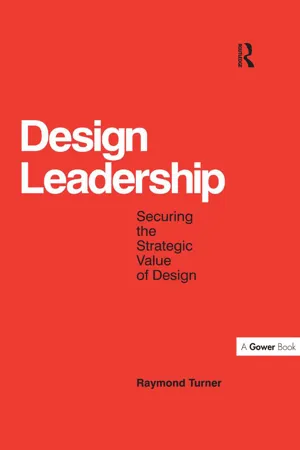![]()
Part One – Preparing the ground
Part One of this book is concerned with how to prepare an organization so that it can use design effectively and helping it understand the case for putting design on to the business agenda. It deals with some basic issues that must be confronted before design will be taken seriously. This includes bringing the sceptics on board – they are the people who see design as a thing rather than a process, or as a tactical resource rather than strategic one, or something that is always a cost to the business rather than an investment for greater return, or who never see it as a key mechanism by which an organization’s reputation depends or can be enhanced.
Why bother with design?
Perhaps we should get this question out of the way first. Why is understanding the role of design so important? Why do we have to bother with it?
The answer is simple. We are surrounded by things, systems, environments and structures. If the natural world did not create them then man did, and part of the process of creating them was designing them! It may not have been called design at the time but the process of creating must have included it, otherwise they would not exist. As will be seen later, design is much more about a process and much less about a thing.
‘design is a process not a thing’
Design is not something that can be avoided. We are surrounded by its use, we interact with things as a result of it. The issue we should be concerned with is how effectively has it been used? In other words, how well does it satisfy the brief that required the work to be undertaken in the first place, how well does the design solution satisfy the wider strategic objectives of the organization commissioning it, and to what extent has shareholder value been optimized by its deployment?
These are serious questions, ones which business leaders must learn to address if they are to maximize design’s potential as a way of maximizing shareholder value. They are questions which design managers and design leaders are required to confront.
All products and services are dependent on design for their very being – without it they cannot exist, and getting the most from the investment is a challenge, and responsibility, for client and designer alike.
On the one hand, the challenge facing the design client, irrespective of company size or sector, is, ‘How do I increase my return on design investment while at the same time reducing the cost of that investment?’ On the other hand, the challenge facing the design consultant is, ‘How do I ensure that my client sees their commitment to design as an investment not a cost?’
Within this challenging environment every successful client/consultant relationship has, at its core, the overriding objective of using design as a means of adding value, and so giving a return on the investment in it. If ‘added value’ is not at the core of this relationship, then the inevitable consequence is the design work will be seen as a commodity where the cheapest wins the day – and, by definition, only one supplier can be the cheapest!
In many spheres the term design has become reduced to being part of a sales slogan used to promote ‘designer sunglasses, designer chocolates, designer jeans or designer alcoholic pop drinks’. This highly inflated and superficial use of the word design, so common in everyday experience, hides its profound potential contribution to making business more successful and society more enjoyable.
Once all this pretentious unintelligible jargon about ‘designerly things’ in sales promotion has been stripped away, there is one inescapable conclusion that you are left with, and it is this, design is a key contributor to making organizations successful in what they set out to do, and so ranks as a commercial imperative.
‘design is a key contributor to making organizations successful in what they set out to do, and so ranks as a commercial imperative’
This proposition is explored fully in the following pages and the main task in front of any design manager or design leader is to get all other relevant people aligned with this view.
To be successful in this means addressing two critical challenges if the ground is to be well prepared for making design work effectively and to maximize its potential, whether that is within organizations, businesses, government departments or our wider society. These are to:
• create a comprehensive understanding of what is possible with design;
• demonstrate the value that design can bring.
This is not easy work. Much of it is about stepping outside the comfort zone of most design-trained people. It means overcoming some basic prejudices if design is to be taken seriously, if it is to contribute to the transformation agenda facing many businesses today, if it is to deliver lasting strategic value.
I remember my first day as Design Director of London Transport and meeting a senior colleague who was chairman and managing director of one of the main operating businesses. A very warm and welcoming person by nature who, at this first meeting, told me clearly that he had not supported my appointment when it came to the Executive Committee for approval. We had never met before this so his position was not based on a clash of personalities. It was based on an assumption, or a prejudice. He believed I would get in the way of his reinvestment programme by trying to exercise some superficial design judgment or personal taste opinions about what his line mangers were doing with design. I remember being somewhat shaken by his comment. I reacted by saying the first thing that came into my mind – ‘You have my reassurance I will not interfere with any design work your managers are engaged in, unless, or course, I don’t believe they are getting value for money from it’.
Subsequently, of course, I had to prove my point and, fortunately, was able to do so. We became close colleagues and he was one of my most supportive allies – all because of being able to show how investment in design could be maximized, could be focused on the challenges his business was facing and would improve the quality of service to his customers.
I only tell this story because prejudice can be a serious hindrance to design effectiveness. This first part of the book suggests ways by which these prejudices may be addressed. It makes no assumptions that this will either be a simple task or quick to achieve. What it does do, however, is propose ways of dealing with five of the most commonly encountered prejudices in business about the role of design. Each one represents a hindrance to getting the most out of design. Often the challenge of addressing them is skipped over in the rush to arrive at the, so called, creative aspects of what design can do. However, if you can win over one manager, that win can be infectious. It can lead to other successes within the business. That can also lead to successes in other businesses when those managers move on in their careers. And best of all, it can lead to those managers embracing greater design challenges in their quest for improvement and change.
![]()
Chapter 1
The sceptics
The first of these prejudices, or issues, is to do with design sceptics. These are the people, sometimes the clients of design consultants, sometimes line managers in a company that employ staff designers, who think they understand the role and potential of design, but only see its most superficial qualities. They see design as a commodity, a service that can be bought on an ad hoc basis whenever they think it appropriate. They do not see it as something that can contribute to the long-term wealth of the business. If this is the case then those sceptics need to be brought onboard.
The issue of how to deal with those people who remain design sceptics has been around for a long time. Alan Topalian 1980 adopted a very strong position on this issue. He reminded people responsible for design that in this kind of work they were not paid to be nice guys. I have come to a similar conclusion that this is not something that can be solved with subtlety and guile. My mantra is equally to the point, persuade by the authority of your argument, not the argument of your authority.
‘persuade by the authority of your argument, not the argument of your authority’
The sceptics view
These business people are easily recognized because they tend to share the general view of many others that design is superficial, something that gets added after the real work has been completed – like the icing on the cake, it’s the finishing touch.
They also believe design is expensive, after all designers charge big fees which business people find hard to accept because they cannot quantify the return for the money they spend on it. Also, design is elitist because it is only big businesses that have the opportunity, and the money, to do something with design. Even though, by far, the largest group of businesses in most countries are in the category of small to medium size, design is not for the small guys – and who needs the icing anyway? Not forgetting that designers don’t live in the real world – they don’t even look like normal people!
And, in the order of things, design is irrelevant because you can’t see that it adds any real value. There are far more important things to think about like market share, turnover and profit margin. The fact that these sceptical views are held by so many people is not surprising considering that we are bombarded with the word design wherever we look and this, inevitably, conditions our expectations of it.
The other view
Of course there is the opposing point of view to that of the sceptics which is that design is not about any of these things. This other view holds that design is one of a company’s most strategically potent assets which can have a direct bearing on its wealth creating capability – so long as you know how to use it!
Design is not superficial
The counter argument is that design is not superficial nor is it about finishing touches. It affects all parts of the business, it is key to making business strategy at least visible and potentially tangible in many other ways. The argument continues that it is an essential ingredient that can breathe new life into old products and help create innovative new ones. It can be the basis of designing spaces from the inside out for user convenience, improved work dynamics and operational efficiency, rather than from the outside in for the aesthetic value of it. It can be key to differentiation and growth in the marketplace.
Although the dictionary definition of the word ‘superficial’ describes it as something to do with the surface of things, this does not always mean it is of no significance. Fashion is an area of design which has much to do with appearance, or things so called ‘superficial’, but that is not to say it is of no importance – far from it. As the following example shows design can go much deeper than this.
Case Example – Dulux Perfect
Figure 1.1 Part of the Dulux Perfect range of products. In this case the paint brush has a tin opener as part of the handle
This proposition is well illustrated by a range of products launched recently by ICI Paints AkzoNobel under the Dulux brand name. See Figure 1.1. Dulux is the company’s best known paint brand. In the UK, 50p of every £1 spent on paint is on Dulux. It made sense therefore to expand into Do-It-Yourself (DIY) home decorating accessories, since only one in ten consumers traditionally purchase a paintbrush or roller with their paint.
Webb deVlam, a brand strategy and design consultancy, used detailed consumer ‘Discovery’ sessions to investigate the painting experience through ethnographic studies of DIY activity in the home. This was supplemented by consultations with trade professionals. The project resulted in Dulux Perfect, a comprehensive range of brushes, rollers and trays, each with unique features that enhance the home decorating activity. These features include a tin opener integrated into brush handles, and a triangular brush to make painting edges easier.
After an initial launch in 2009, which resulted in a 5 per cent share of the £160 million home decorating accessories market, the launch of the extended range in March 2010 generated continued success. Annual sales have increased 36.49 per cent and are still growing. Distribution has more than doubled in major accounts and Dulux Perfect won the DIY Week ‘Product of the Year’ Award.
Design is not expensive
Equally, design is not an expensive new overhead but something that companies are already engaged in and could almost certainly do more cost effectively. Designing the right solution in the first place costs less than designing the wrong solution and then having to manage the fall out from that bad decision. There is well-documented evidence that design can save money, not only by making things easier and cheaper to produce, but also by having a positive affect on the cost of ownership.
Case Example – Eglin Concourse airport seating
Figure 1.2 Eglin airport seating, concept design by Robert Heritage RDI
A good example of designing for ‘cost of ownership’ is that of the airport seating system manufactured by Eglin Concourse International and design concept by Robert Heritage OBE RDI (1927–2010). See Figure 1.2.
A significant cost in the use, and therefore ownership, of airport seating relates to the time, money and operational disruption caused by the replacement of traditional upholstery. Historically, in many cases the seating used by many of UK’s airports required the whole seating unit to be removed from the departure lounges and waiting areas, and taken off site for reupholstery. This was mainly because the fabric and foam were fixed directly to the seating frame and needed the resources of an upholsterer’s workshop for their replacement. Consequently, either a stock of additional seating had to be stored somewhere and made available for when those in use needed maintenance, or there would be a shortage of seats for passengers to use while the seats were away for repair. Neither of these options was acceptable to the airport owners nor the passengers.
One of the many requirements of the brief for the redesign of the seating commissioned by BAA, the airport company that owns Heathrow and operates many others around the world, was to address the problem of reupholstery. Others included reducing the footprint to achieve greater seating capacity, minimizing security risk by being able to easily see under it, reducing clea...


